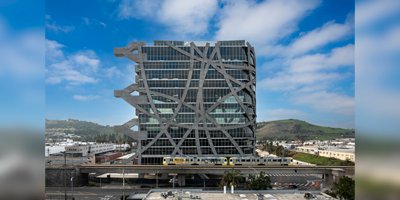The California office tower (W) Rapper is named after its wrapping steel exoskeleton, which supports the 16-story building. The building is not only significant for its appearance, but also for its sustainability features.
The structural concept for (W)rapper, built in a former industrial and manufacturing area in downtown Los Angeles and Culver City, originated in 1998 and was initially presented by the project’s architect, Eric Owen Moss Architects (EOMA ) in an exhibition at the Wexner. Center in Columbus, Ohio. Unlike conventional high-rise buildings that rely on columns organized along modular grid lines, the tower uses a network of curvilinear bands emanating from multiple geometric central points to provide support. Each curved band wraps around the predominantly rectangular building envelope and folds around each vertical and horizontal corner until it reaches the ground.
To ensure seismic safety, the bands are supported by an isolated base that separates the tower structure above from the insulating foundations below. This design allows the building to respond and move safely during seismic events. In terms of sustainability, the isolated base structure significantly improves the building’s resilience, making it five times more earthquake-resistant compared to a typical American skyscraper. In the event of a major earthquake, the rapper (W) would remain standing and ready to occupy it the next day.
(W)rapper’s structural life cycle is a key measure of its sustainability, greatly reducing its carbon footprint over its lifetime. Compared to more conventional structural concepts, (W)rapper offers both the city and its tenants the highest seismic safety rating possible in the US, making it the only high-rise commercial office building in the country that uses such an isolated structure.
(W)rapper’s steel bands are coated with cement fireproofing, and the core of the building is adorned with a two-layer cement plaster finish. Concrete is not used in the structural or fireproof concept of (W)rapper. By placing the bands around the perimeter of the building, an open, column-free floor plan is created, offering maximum flexibility for interior planning. The elevator and utility core of the building are moved to the south, freeing up the office interiors and providing more flexibility in the floor plan.
The seventeen office floors at (W)rapper offer three different floor-to-floor height options, which are approximately 4.27m (14ft), 5.18m (17ft) and 7.32m (24ft ). In addition, a mezzanine hangs from the ceiling above the floor 7.32 m (24 ft), offering tenants a wide range of use and possibilities for spatial experience. Minimal obstructions caused by perimeter bands provide unobstructed views of the entire Los Angeles Basin from every floor.
Located along the Expo Line light rail, which connects West Los Angeles with downtown, the (W)rapper project aligns with the city’s long-term planning goal of increasing density along mass transit routes. The project strongly encourages the use of public transport and the reduction of fossil fuel consumption by providing limited public and private parking options, while establishing a direct pedestrian link from the train to the building. In fact, the building’s lobby is 228 m (750 ft) from the Exposition Light Rail transit station via a landscaped pedestrian walkway and direct stairs to the lobby. In this neighborhood, which previously limited the height of buildings to 13 m (45 ft), (W)rapper introduces a new scale, density and multipurpose functions.
Some of the other sustainability features of the office tower are:
- Low carbon footprint. The project is designed for a life cycle five times longer than a typical high-rise office building, resulting in a significant reduction in carbon use over the life of the building.
- Leadership in energy and environmental design (LEED) silver equivalency. The building exceeds all of California’s strict green building requirements and has performance equivalent to a LEED Silver rating.
- Reduced sun exposure. The self-shaded building configuration with a south-facing offset core, exterior band structure, and interior glazing reduces heat from solar exposure.
- High performance facade. Energy-efficient facade with high-performance, low-emissivity glass, insulating and light gypsum-clad walls and light-colored reflective roof.
- Natural lighting. Shallow floor plates bring natural light to the entirety of each floor.
- Flexible interiors. Column-free interiors allow for maximum tenant flexibility, limiting the cost and carbon footprint of tenant improvements.
- High performance mechanical systems. Energy-efficient and scalable Mechanical Variable Refrigerant Flow (VRF) system with dedicated outdoor air filtration system and automated Building Management System (BMS) for optimization.
- Natural site cooling. The building’s orientation maximizes westerly breezes from the Pacific Ocean, and the site’s water feature, The Puddle, provides evaporative cooling.
- Water conservation. Non-contact plumbing installations with maximum water conservation.
- Water recycling. All stormwater from the site is collected, filtered and reused for irrigation using an on-site cistern.
- Acoustic performance The glass facade adjacent to the Metropolitan Transit Authority (MTA) train is triple-glazed to provide quiet interiors.
- mobility The site is adjacent to major cycle routes and the project includes ample short and long term cycle parking with on-site showers.

